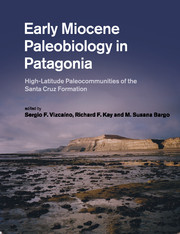Book contents
- Early Miocene Paleobiology in Patagonia
- Frontispiece
- Early Miocene Paleobiology in Patagonia
- Copyright page
- Contents
- Contributors
- Preface
- 1 Background for a paleoecological study of the Santa Cruz Formation (late Early Miocene) on the Atlantic Coast of Patagonia
- 2 Tephrochronology of the Miocene Santa Cruz and Pinturas Formations, Argentina
- 3 Absolute and relative ages of fossil localities in the Santa Cruz and Pinturas Formations
- 4 Sedimentology and paleoenvironment of the Santa Cruz Formation
- 5 Oysters from the base of the Santa Cruz Formation (late Early Miocene) of Patagonia
- 6 Ichnology of distal overbank deposits of the Santa Cruz Formation (late Early Miocene): paleohydrologic and paleoclimatic significance
- 7 Fossil plant studies from late Early Miocene of the Santa Cruz Formation: paleoecology and paleoclimatology at the passive margin of Patagonia, Argentina
- 8 Amphibians and squamate reptiles from the Santa Cruz Formation (late Early Miocene), Santa Cruz Province, Argentina: paleoenvironmental and paleobiological considerations
- 9 Diversity and paleobiology of the Santacrucian birds
- 10 Paleoecology of the Paucituberculata and Microbiotheria (Mammalia, Marsupialia) from the late Early Miocene of Patagonia
- 11 Paleoecology of the mammalian carnivores (Metatheria, Sparassodonta) of the Santa Cruz Formation (late Early Miocene)
- 12 Paleobiology of Santacrucian glyptodonts and armadillos (Xenarthra, Cingulata)
- 13 Paleobiology of the Santacrucian sloths and anteaters (Xenarthra, Pilosa)
- 14 Paleobiology of Santacrucian native ungulates (Meridiungulata: Astrapotheria, Litopterna and Notoungulata)
- 15 Paleobiology of Santacrucian caviomorph rodents: a morphofunctional approach
- 16 Paleobiology of Santacrucian primates
- 17 A review of the paleoenvironment and paleoecology of the Miocene Santa Cruz Formation
- Index
2 - Tephrochronology of the Miocene Santa Cruz and Pinturas Formations, Argentina
Published online by Cambridge University Press: 05 June 2013
- Early Miocene Paleobiology in Patagonia
- Frontispiece
- Early Miocene Paleobiology in Patagonia
- Copyright page
- Contents
- Contributors
- Preface
- 1 Background for a paleoecological study of the Santa Cruz Formation (late Early Miocene) on the Atlantic Coast of Patagonia
- 2 Tephrochronology of the Miocene Santa Cruz and Pinturas Formations, Argentina
- 3 Absolute and relative ages of fossil localities in the Santa Cruz and Pinturas Formations
- 4 Sedimentology and paleoenvironment of the Santa Cruz Formation
- 5 Oysters from the base of the Santa Cruz Formation (late Early Miocene) of Patagonia
- 6 Ichnology of distal overbank deposits of the Santa Cruz Formation (late Early Miocene): paleohydrologic and paleoclimatic significance
- 7 Fossil plant studies from late Early Miocene of the Santa Cruz Formation: paleoecology and paleoclimatology at the passive margin of Patagonia, Argentina
- 8 Amphibians and squamate reptiles from the Santa Cruz Formation (late Early Miocene), Santa Cruz Province, Argentina: paleoenvironmental and paleobiological considerations
- 9 Diversity and paleobiology of the Santacrucian birds
- 10 Paleoecology of the Paucituberculata and Microbiotheria (Mammalia, Marsupialia) from the late Early Miocene of Patagonia
- 11 Paleoecology of the mammalian carnivores (Metatheria, Sparassodonta) of the Santa Cruz Formation (late Early Miocene)
- 12 Paleobiology of Santacrucian glyptodonts and armadillos (Xenarthra, Cingulata)
- 13 Paleobiology of the Santacrucian sloths and anteaters (Xenarthra, Pilosa)
- 14 Paleobiology of Santacrucian native ungulates (Meridiungulata: Astrapotheria, Litopterna and Notoungulata)
- 15 Paleobiology of Santacrucian caviomorph rodents: a morphofunctional approach
- 16 Paleobiology of Santacrucian primates
- 17 A review of the paleoenvironment and paleoecology of the Miocene Santa Cruz Formation
- Index
Summary
The Santa Cruz and Pinturas Formations (SCF and PF) are two partially coeval formations in the southern part of Santa Cruz Province, Argentina, that were deposited during the Early to Middle Miocene. The SCF underlies the coastal plain between 47.0° and 51.6° S and extends from the Atlantic Coast into the Andean foothills. The PF has a more restricted distribution centered on eastern tributaries of the Rio Pinturas along the northern perimeter of the SCF. Both formations have abundant tephra and tuffaceous sediments with likely sources in volcanoes associated with emplacement of the late Cenozoic South Patagonian batholith. This study re-evaluates the age of the SCF and the relationship of the SCF to the PF, adding some radiometric dates to those previously published and using the methods of tephrochronology. Tephra samples were collected from 26 localities in the SCF and PF. Glass shards were analyzed by electron microscopy. Ten tephra samples were analyzed by the 40Ar/39Ar method: nine from the SCF and one from the PF. Results of these analyses, in conjunction with previous studies, indicate that there are at least 38 individual tephra layers in the SCF, while there are likely many more tephra than the six analyzed from the PF. Of the 38 tephra layers in the SCF, 16 are shared by two or more sections, with one key tephra, the Toba Blanca, present in eight and possibly nine localities from 51.6° S northward to 47.0° S, over a distance of ~525 km. Integrating results of the tephra correlations and radiometric ages indicates that the SCF spans the interval ~18 Ma to 16 Ma in the Atlantic coastal plain and ~19 to 14 Ma in the Andean foothills, with a chronologic overlap between the PF and lower part of the SCF. With this tephrochronology in place, studies of space-time variations such as rates of sediment accumulation, composition of mammalian faunas, facies changes, and other aspects of the SCF and PF can be fruitfully pursued.
- Type
- Chapter
- Information
- Early Miocene Paleobiology in PatagoniaHigh-Latitude Paleocommunities of the Santa Cruz Formation, pp. 23 - 40Publisher: Cambridge University PressPrint publication year: 2012
- 52
- Cited by



